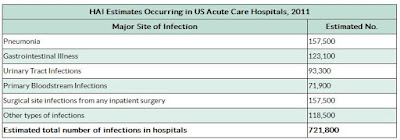#11,829
While exotic infectious diseases like avian flu, MERS, and Ebola tend to capture the headlines, every day thousands of people are sickened - and many are killed - by infections contracted while being treated for something else in a hospital or clinic.
The most recent assessment of the burden of HAIs in the United States by the CDC reads:
In 2014, results of a project known as the HAI Prevalence Survey were published. The Survey described the burden of HAIs in U.S. hospitals, and reported that, in 2011, there were an estimated 722,000 HAIs in U.S. acute care hospitals (see chart below). Additionally, about 75,000 patients with HAIs died during their hospitalizations. More than half of all HAIs occurred outside of the intensive care unit.
This is summed up by the sobering statement that `On any given day, about one in 25 hospital patients has at least one healthcare-associated infection.'
Of course, this isn't just an American problem, its a global concern. One that is increasingly complicated by the rise in antimicrobial resistant bacteria, such as MCR-1, NDM-1, and CRE.
Yesterday the journal PLoS Medicine published an open-access study on the burden of 6 major HAIs in the EU. I've included some excerpts, but you'll want to follow the link to read it in its entirety.
Burden of Six Healthcare-Associated Infections on European Population Health: Estimating Incidence-Based Disability-Adjusted Life Years through a Population Prevalence-Based Modelling Study(SNIP)
Alessandro Cassini , Diamantis Plachouras , Tim Eckmanns, Muna Abu Sin, Hans-Peter Blank, Tanja Ducomble, Sebastian Haller, Thomas Harder, Anja Klingeberg, Madlen Sixtensson, Edward Velasco, Bettina Weiß, Piotr Kramarz, [ ... ], Carl Suetens
PLOS
Published: October 18, 2016
http://dx.doi.org/10.1371/journal.pmed.1002150
Abstract
Estimating the burden of healthcare-associated infections (HAIs) compared to other communicable diseases is an ongoing challenge given the need for good quality data on the incidence of these infections and the involved comorbidities. Based on the methodology of the Burden of Communicable Diseases in Europe (BCoDE) project and 2011–2012 data from the European Centre for Disease Prevention and Control (ECDC) point prevalence survey (PPS) of HAIs and antimicrobial use in European acute care hospitals, we estimated the burden of six common HAIs.
Conclusions
We estimated the EU/EEA burden of HAIs in DALYs in 2011–2012 using a transparent and evidence-based approach that allows for combining estimates of morbidity and of mortality in order to compare with other diseases and to inform a comprehensive ranking suitable for prioritization. Our results highlight the high burden of HAIs and the need for increased efforts for their prevention and control. Furthermore, our model should allow for estimations of the potential benefit of preventive measures on the burden of HAIs in the EU/EEA.
Author Summary
Why Was This Study Done?
- Infections acquired in hospitals are a common and largely preventable complication of hospitalisation and surgery affecting approximately 1 in 20 patients.
- We measured the burden of healthcare-associated infections (HAIs) in disability-adjusted life years (DALYs), thus also enabling comparison with the burden of other diseases.
- Calculating the burden of HAIs is challenging given the underlying disease that caused the initial hospitalisation.
What Did the Researchers Do and Find?
What Do These Findings Mean?
- We estimated the burden of six common HAIs in DALYs: healthcare-associated pneumonia (HAP), healthcare-associated urinary tract infection (HA UTI), surgical site infection (SSI), healthcare-associated C. difficile infection (HA CDI), healthcare-associated neonatal sepsis, and healthcare-associated primary bloodstream infection (HA primary BSI).
- The data source for the number of infections was the European point prevalence survey of healthcare-associated infections and antimicrobial consumption in acute care hospitals.
- HAI-attributable outcomes and length of stay were based on a systematic review of the literature. Moreover, life expectancy was adjusted according to the severity of the underlying condition.
- More than 2.5 million cases of HAI occur in the European Union and European Economic Area (EU/EEA) each year, corresponding to approximately 2.5 million DALYs.
- HAP and HA primary BSI were responsible for the largest part of the total burden of HAIs.
- The total burden of the six HAIs in Europe was higher than that of all other communicable diseases under surveillance at ECDC.
- HAIs represent a significant burden among infectious diseases in Europe, exceeding the burden of other infections like influenza and tuberculosis.
- Increasing efforts for prevention are imperative to decrease this burden.
(Continue . . . )
Today the ECDC has published a summary of this report, which is available at:
Estimated burden of healthcare-associated infections higher than that of other infectious diseases such as influenza, HIV/AIDS and tuberculosis together, study says
19 Oct 2016
A study published today by PLOS Medicine, estimates the combined burden of six healthcare-associated infections as being higher than that of diseases such as influenza, HIV/AIDS and tuberculosis together. More than 2.5 million cases of healthcare-associated infections occurring each year in the EU/EEA are estimated to result in a burden of approximately 2.5 million disability-adjusted life years (DALYs), a commonly used metric for measuring the impact of diseases on the health of a population.
(Continue . . )
For more on the impact of HAIs, you may wish to revisit some of these earlier blog posts:

